What is digital PR and does it need a rethink?
The traditional approach to public relations is known to focus on press releases and curating perfect media lists. You know, securing coverage hoping for brand awareness and online presence to just organically follow.
However, now digital PR efforts are strong on mixing an SEO strategy focused on link building with actions that yield influence and online visibility.
In-house teams and agencies that stay ahead know mentions are still important (and probably will be forever), but also put a lot of effort into starting movements ignited by quality content that results in target audience loyalty and engagement.
Read this guide to know more about how performance-driven PR can work hand in hand with influence-led approaches to positively affect your brand's online presence.
Quantify digital PR efforts for free with all-in-one tool
Try Prowly completely free for 7 days in a platform that has everything you need for PR.
- All-in-one software: Get everything you need in one tool for PR, incl. media database, outreach, reporting, and more
- Transparent Pricing: Plans start at $258/month
- Comprehensive Monitoring: Track the web, social media, print, and broadcast mentions
A digital PR strategy goes beyond vanity metrics
Unlike traditional PR, where the main objective is in an answer to the question, "How many mentions did we get?" an effective digital PR strategy recognizes that the questions should be, "Did we change the conversation?" and "Did we influence our target audience?"
The new goals of digital PR
While your clients might still want to see vanity metrics and concrete data, it's your job to make sure they also understand that success isn't only measured by the number of media mentions, backlinks, and press releases being sent out.
These traditional metrics don't really capture the full impact of an actionable, well-thought out digital PR strategy. You're probably immune to this by now, but hearing "How many mentions did we get?" is sure to make your blood pressure rise a bit higher now and then.
Instead, it's important to shift the mindset a bit and see if your work has changed not only the statistics, but also the conversation.
Has your work and the actions you took in your digital PR strategy influenced the industry in any way?
These questions are much more important than the former.
Backlinks are good, but brand authority is great
Although backlinks still matter, their real value lies in how they build credibility. Don't focus on chasing links just to boost SEO. Rather, focus on securing placements that will increase your online reputation, reinforcing expertise and trust.
Community buzz over media coverage
Traditional media headlines are awesome but, in retrospect, they don't tend to create lasting influence and engagement. Today, digital PR aims to spark conversations where industry experts, thought leaders, and your target audience keep on chatting.
From press releases, to earned, organic attention
Yes, press releases serve a purpose like no other, but they do little in terms of creating the type of storytelling, collaborations, and initiatives that digital public relations can create.
💡 Case study: Duolingo's unhinged TikTok digital PR content
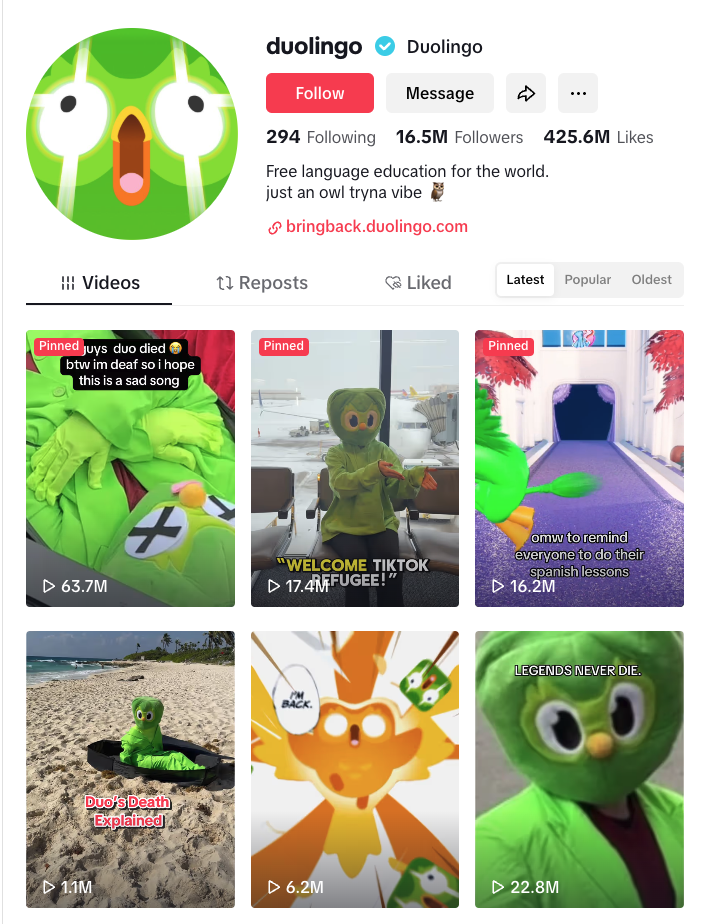
There's not a single chance you haven't heard about their brand image.
Unconventional, yet humorous, they've created viral content that resonated with audiences far beyond traditional PR.
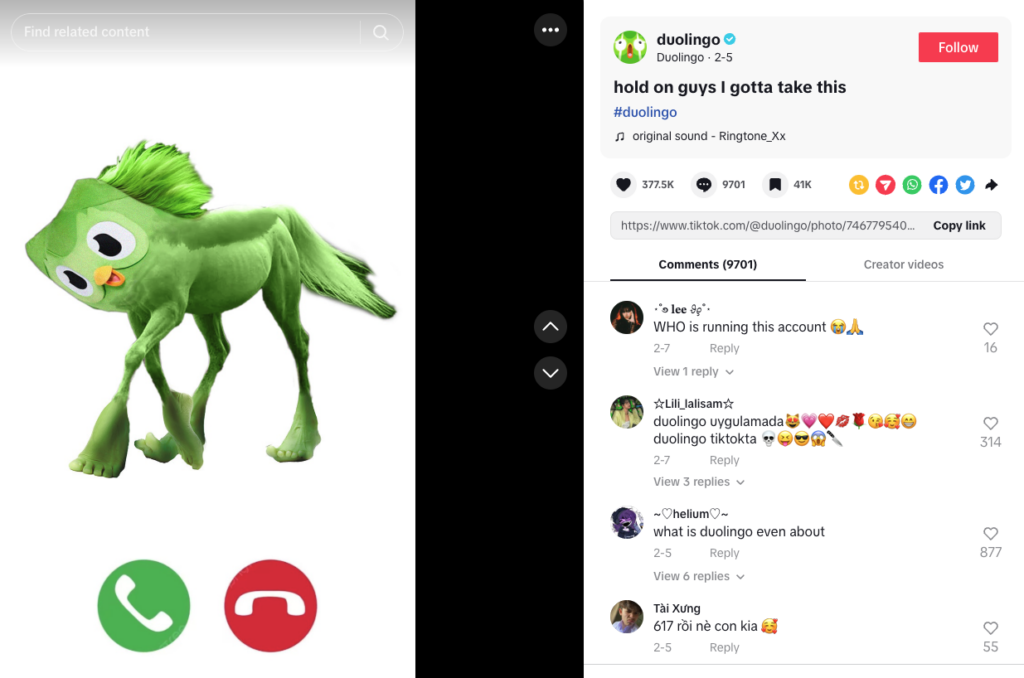
They've leaned into playful, meme-driven storytelling, and in turn the brand generated a massive increase in brand awareness, increased domain authority and a getting boost in search engines.
Performance PR: measuring real business impact
How to track digital PR’s true value
In the way traditional public relations is done, success is usually measured by the number of press hits you get and their reach. However, in digital PR, metrics used to assess whether or not a particular strategy is working go far beyond that.
When measuring your digital PR strategy, consider:
SEO metrics
👉 Organic traffic - monitor how your PR-driven content contributed to website visits from current and new guests.
👉 Backlink profile - track websites that link back to yours and their domain authority, strength and relevance.
👉 Branded search growth - how many people are searching for you on their own? This is important and measures general brand awareness.
Brand metrics
👉 Social mentions - see how many times your brand is talked about on social media platforms, discussion forums and so on.
👉 Share of voice - a metric known to many, it's simply a way to measure and compare your brand's media presence vs. your competitors.
👉 Sentiment analysis - just because your digital PR campaign gained traction, doesn't mean it's all great. Always remember to check sentiment.
Revenue metrics
👉 ICP share - do you know how many of your ideal customers are actually engaging with your digital PR efforts? If not, dive into the topic for insightful analytics ASAP.
👉 Leads - measure how many potential customers or prospects want to buy your product.
👉 Pipeline impact - this one measures how digital PR strategy affects awareness and translates directly into sales opportunities by tracking conversions and attributed revenue.
3 Top tools to measure digital PR performance
Choosing the right tools to measure digital PR and digital marketing is crucial in making sure your strategy is going according to plan. Here are some of the best choices:
- Semrush: an all-in-one digital marketing tool that helps companies analyze their online presence. In terms of digital PR, Semrush is great for backlink analysis, organic traffic tracking, content marketing, and competitive benchmarking.
- Google Search Console: use it to track brand-driven search growth, including monitoring branded search queries, measuring impressions and clicks, analyzing trends over time, and assessing page performance.
- Prowly: an all-in-one PR tool that helps build relationships with journalists while managing your brand's reputation. Track online PR, analyze link building activities, and keep tabs on the digital space with a robust media database, PR CRM, media monitoring, and PR reports.
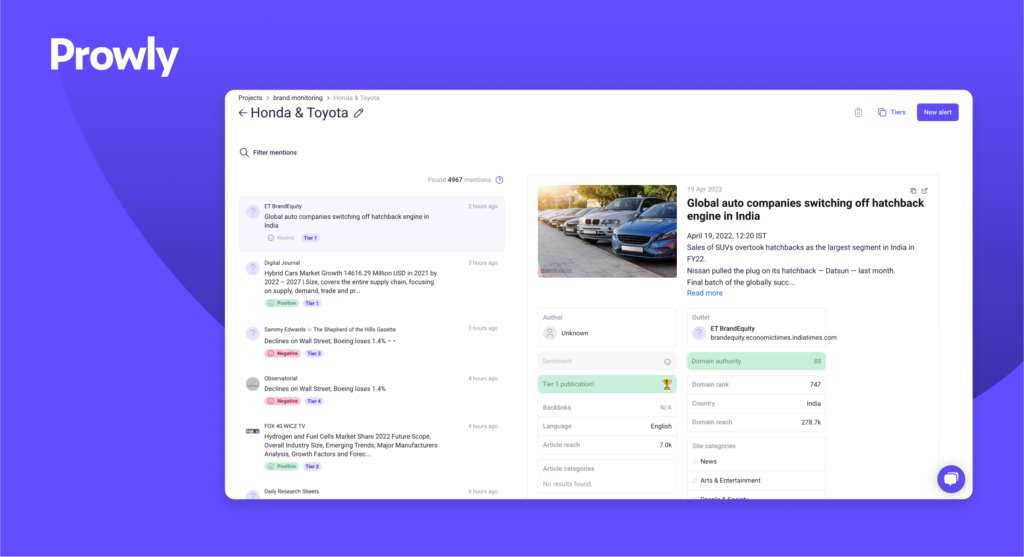
💡 Case study: Notion's user-driven digital PR strategy
Did you know that Notion's growth wasn't fueled by traditional public relations and press releases?
Rather, it was built by a passionate user base that organically shared their workflows, templates, and use cases. Such tactics led to widespread adoption, generating quality backlinks and organic media coverage that boosted their search rankings.
Try Prowly's media monitoring free for 7 days
Start tracking your brand and keywords for free (no credit card required) in Prowly.
- Comprehensive monitoring: Track the web and social media mentions.
- Transparent pricing: Plans start at $258/month
- All-in-one platform: Get everything you need in one tool for PR, incl. media database, outreach, reporting, and more
Reverse Digital PR: Build the buzz before you have the story
Create communities before building campaigns
Traditional PR starts with some kind of a campaign then focuses on generating attention. Is this the right way to go? Not in 2025! Reverse digital PR flips the process around and emphasizes building engaged communities first.
The key thing is, you don't need to start big. Begin with micro-communities, Slack groups, Discord servers, Reddit channels, and Twitter (X) to foster genuine connections with a niche target audience.
Whether you are a digital PR specialist or work in digital PR agencies, you know how important it is to test narratives and refine messaging before you start launching your media outreach at full force.
Host Reddit AMAs. Build Substack newsletters. All these types of ideas serve as pre-audience builders and can help you create a loyal following (or base) before you kick off your digital presence with the formal campaigns that traditional PR focuses on.
💡 Case study: Lenny Rachitsky's Substack strategy
This former Airbnb product lead started sharing insights and knowledge through his Substack newsletter and managed to build a highly engaged audience of product managers and start-up professionals.
Since he established credibility and thought leadership first, he attracted media attention naturally, making him a frequently quoted expert in the industry.
Strategic boldness and controversies
Any successful digital PR campaign needs to have some kind of a stance.
It doesn't matter what the topic is. While you don't need to spark a controversy that will make people's heads turn, you should have a fresh and new angle in mind.
However, you can always engage in planned polarity. Some of the biggest brands do it and they understand that they don't need universal approval from everyone to build influence. By standing firm on their values, they create even deeper connections with their target audience while naturally sparking conversations.
Keep in mind that this involves taking calculated risks.
Being provocative or controversial can improve brand awareness or result in negative sentiment, all depending on how the broader audience receives it.
Tip: Make sure to invest in good media monitoring software (such as Prowly) to prevent potential crises, especially if you plan to incorporate a bit of controversy into your digital strategy. When choosing a media monitoring service, make sure it’s tailored to local media — for example, the UK market.
💡 Case study: Patagonia's "Don't buy this jacket" campaign
In 2011, Patagonia launched a Black Friday campaign with an anti-consumerist message asking people to reconsider unnecessary spending and purchases.

While some thought it may end up hurting sales, their bold stances increased brand awareness, loyalty, and drove positive media coverage.
How to create buzz ethically?
Creating noise around your cause is only right if it's genuine and not just seeking attention. Take a stance on issues that truly matter to you and make sure they also align with your audience's core values.
Authenticity builds trust, while opportunistic controversies can backfire and hurt your brand visibility. Your goal here isn't just to provoke but to spark meaningful conversations that will be picked up by media outlets and online channels.
Human-led vs. AI-led digital public relations
Digital PR has also been transformed by AI (no surprise there). It now offers powerful tools for journalist research, sentiment analysis, and trend prediction. While AI helps automate tasks and speed up workflows, it can't replace the human touch.
Public relations is still fundamentally about media relations and building connections. Where humans win is in emotional intelligence, creative storytelling, and long-term relationship building. PR professionals bring the type of empathy, authenticity, and nuance that AI simply can't replicate.
The key? Balancing AI for efficiency while keeping humans at the core of digital PR efforts.
👉 For example, AI can help you organize notes, draft a pitch, and even generate responses that mirror a personal conversation with a journalist. It can also suggest personalized hooks and engaging subject lines, making outreach more effective.
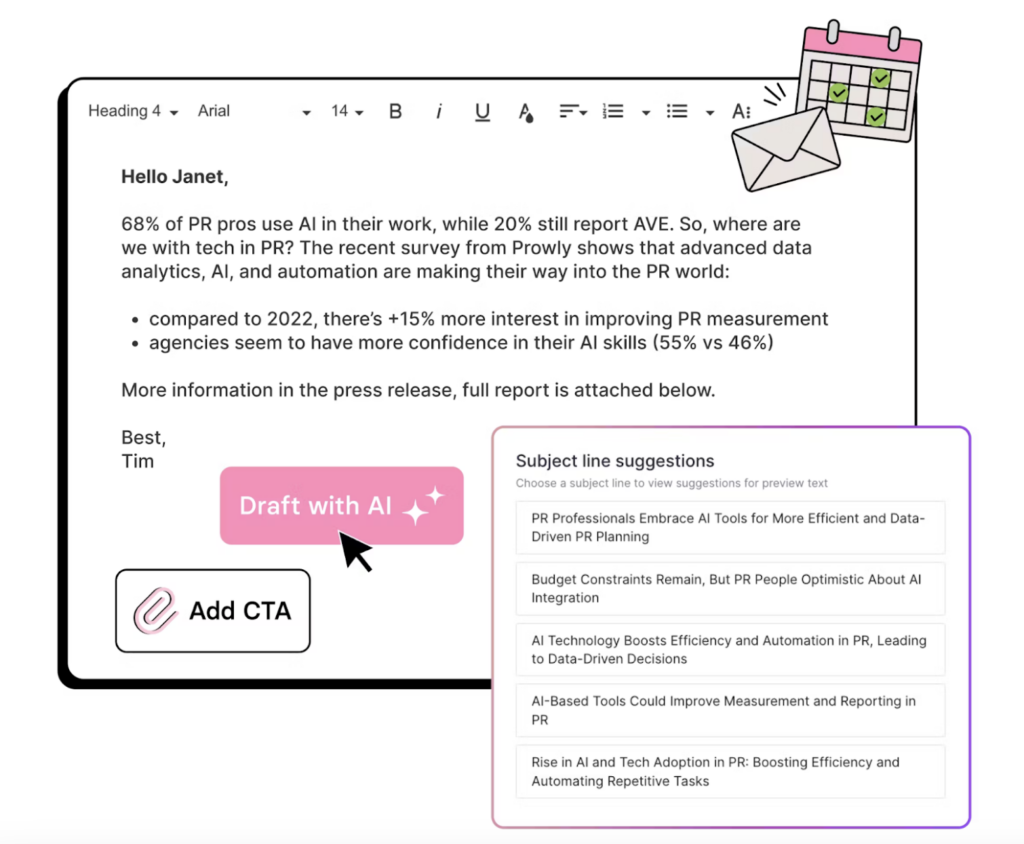
Wondering how it works in practice? Try Prowly free for seven days - no credit card needed.
Is PR for SEO dead? Where digital PR serves for search experience
Today, search engines prioritize brand authority, content relevance, and user experience. Link volume isn't as important anymore, as digital PR now plays a broader role in shaping the way users interact with a brand.
The new goal isn't just to boost organic rankings. It's about owning the conversation, building credibility, and ensuring that your efforts sustain brand awareness in the long run.
Don't forget about backlinks, but care for your digital PR strategy more
Backlinks remain a key part of SEO, but relying too heavily on them isn’t enough. Search engines now prioritize brands that demonstrate EEAT (Expertise, Experience, Authoritativeness, Trustworthiness).
Instead of just chasing links, digital PR should also focus on building brand search demand, where more people are organically searching for your brand. Another key factor is topical authority, which comes from earning brand mentions from highly respected websites.
💡 Case study: Zapier's SEO strategy
This company focuses on more than just getting backlinks. It dominates automation-related searches through authoritative content and strategic partnerships.
By consistently publishing valuable resources and ranking for automation-related searches, Zapier has positioned itself as the go-to solution in its niche.
Digital PR’s secret weapon: First-party data as the new “exclusive”
Why proprietary data is media gold
Journalists are always on the hunt for fresh insights. Brands and teams that produce original reports with exclusive data can become trusted industry sources, increasing their chances of getting attention from digital channels and online publications. Think original surveys, expert opinions, and so on.
How to use (and get) first-party data
Start off by surveying the community, the users, analyzing internal product data (always remember about confidentiality), and turn them into compelling stories. You can use different content formats here, depending on what sticks best with your audience.
💡 Case study: Spotify's Wrapped campaign
It's truly more than just an end-of-the-year recap. It fuels massive organic traction by transforming user data into personalized, shareable content.
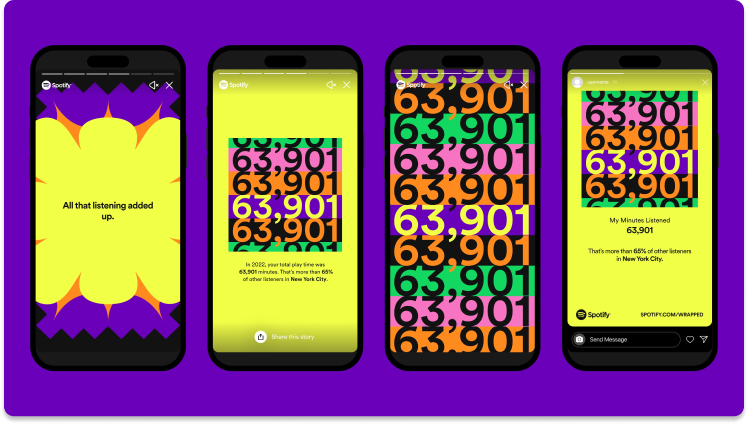
This way, millions of people share their results on social media, and in turn, Spotify gains viral engagement and extensive media coverage without relying on traditional PR tactics.
The “invisible PR” strategy: Can you win without press releases?
Why the best digital PR today doesn’t look like traditional PR at all
Traditional PR specialists are taught to write compelling press releases and then use outreach as a promotional tactic. However, the brands that are staying ahead of the curve nowadays aren't just creating engaging content.
Increasing brand awareness starts with building strong communities. While media placements are still important, they are slowly losing the authority that news stories held years ago.
Here's how you can switch the old with the new:
| Traditional PR | Digital PR | |
| Pitching | Outbound, proactive approach where you reach out to media contacts, bloggers, and influencers, to get them to talk about your story. As a result, you're competing against hundreds of pitches in a limited space. | Inbound, pull strategy, based on creating content and building relationships through platforms frequented by your journalists, influencers, and, most of all, your audience. |
| Strategy | Focused on pitching stories and hoping for placement. Tracking success with the number of mentions and impressions. Coverage is temporary as the news cycle moves on. | Publishing your own stories and not waiting for media coverage. Building brand awareness with everyone, not just journalists. Connected directly to your relevant audience. |
| Longevity | Having a short window to cover a story, where attention fades right after the conversation moves on and doesn't stay relevant. | Creating ongoing narratives while focusing on online channels. Sharing industry trends, customer stories, and ongoing insights. |
3 brands winning with invisible digital PR
- Notion - did you know they barely did any advertising? It’s actually their users who became their biggest advocates, creating and sharing templates, workflows, setups, and showing how they customize the tool to their own needs. They didn’t need traditional PR, their users did it for them.
- Airbnb - unique stays in treehouses or a fabulous breakfast coffee in Tuscany? Airbnb’s strategy was to highlight their users’ experiences by turning the stories of hosts and guests into pieces of content.
- Figma - first, there was a community and then PR followed. They created a space for designers to collaborate, share feedback, and essentially learn from one another. This invisible PR tactic is actually what made them indispensable in the design world.
How to implement invisible digital PR in your strategy
1️⃣ Turn your customers into storytellers
Create spaces or spark a digital PR campaign where they can share their experiences, their success stories, how they use your software, or anything else that makes sense for your particular case. You can encourage them to do so by highlighting their content on your website or online platforms. Also, remember that things like case studies, testimonials, and organic social media posts carry more importance than traditional PR corporate messaging.
2️⃣ Start caring more about your fans
Not just "fans" but brand evangelists, loyal customers, and influencers who have a strong, positive connection to your brand. Provide them with exclusive insights, early access, or recognition on the platforms where you’ve built a community. Give them space to share their experiences and amplify your message organically.
3️⃣ Create content that's PR newsworthy by nature
In digital PR, you really need to get your creative juices flowing and think about what content has the potential to gain traction in your target community. For example, if you're in the health niche, an infographic on what to eat and what to avoid may work better than an article. You have to start thinking about what makes for a compelling story and what content is likely to be shared later on so you can, in turn, earn high quality backlinks from authoritative sites.
Looking for a comprehensive all-in-one PR tool?
Try Prowly completely free for 7 days in a platform with everything you need for PR.
- All-in-one software: Get everything you need in one tool for PR, incl. media database, outreach, reporting, and more
- Transparent pricing: Plans start at $258/month
- Comprehensive monitoring: Track the web and social media mentions.
Final food for thought
Although digital PR is something you need to implement ASAP if you haven't already, traditional PR isn't going anywhere. However, the benefits of digital PR are hard to ignore if you want to keep up with the industry and maintain brand awareness.
It's time for you to own the conversation and shift your thinking from traditional link building, to setting up foundations for your brand to influence your target audience. When your story is as compelling as it gets, public relation becomes so effortless that you'll own the niche and have journalists come to you (as opposed to you coming to them).
To measure your work in digital PR, consider utilizing a tool like Prowly in your daily workflow. From finding opportunities using the extensive media database, to getting cold-hard data through sentiment analysis and engagement, you'll be able to quantify your work in no time.

